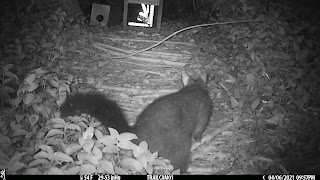It is currently the school holidays in New Zealand, we have a number of students who are currently running trials during the school holiday break, focussed on possums and using a sound lure in conjunction with a Timms Possum Trap, as seen left. We have seen extremely encouraging initial results from these latest trials, including having possums entering into buildings (barns) to engage with sound lures and subsequently traps. We have also have results coming from outdoor trials of the sound lures - again the initial results from these trials appear to be extremely positive showing increased possum activity at locations where the sound lure is being deployed. These sites have double blind situations with two different locations on the same farm one featuring a sound lure and Timms and the other just a Timms. Both locations are being monitored by Browning trail cameras.

At deployment site one we have noticed a significant change in the activity. We have started in the last two weeks to use the 'feather' unit which is an adapted version of the sound lure. There is the basic unit but we have the motor working in conjunction with the unit, when the sound lures is activated there is a motor that runs at the same time. This is currently turning a feather, however we are going to develop this further trying addiitonal material and movement items. At least one feral cat (pictured) appears to have taken up residence in the area by the river. The result is that we have seen a significant reduction in mice and rats in the area. While we have taken a short break with our recording at this location the cat was visible prior to the break starting and is now featuring significantly at the site. We are not interested in trapping cats at this stage however the cat is shown significant interest in the lure, which is currently making possum noises. (We have in the past seen cats show significant interst in chicks or chirping bird sounds).

Finally we would like to acknowledge the support on Fonterra again to allow our project to continue with a stoat focus. We also need to thank Bryan and Feral Control who are currently running trials for us using a number of our units.
This trial has not yet been completed however there are already some results of significance - the photograph on the left showing one of the 'distress rabbit' sound lure units which has been deployed inside of a DOC200. As can be shown from the photograph a stoat has entered the trap and been disposed of as a result.
We are awaiting the results of this trial and looking to modify the units as a consequence of the feedback and the expertise that are available to us. We will publish the full results of this trial when it is complete.
Of considerable interest to us is this is the second time of recording a stoat strike on one of the sound lures in an unusually short space of time. We have previously detailed how at the New Plymouth Airport we caught a stoat within three days of our first deployment at a location that stoats were not suppossed to be at. While the capture above is not such an area, as stoats were known to be operating here, the capture is in a very short space of time - four days after the setting of the trap.






